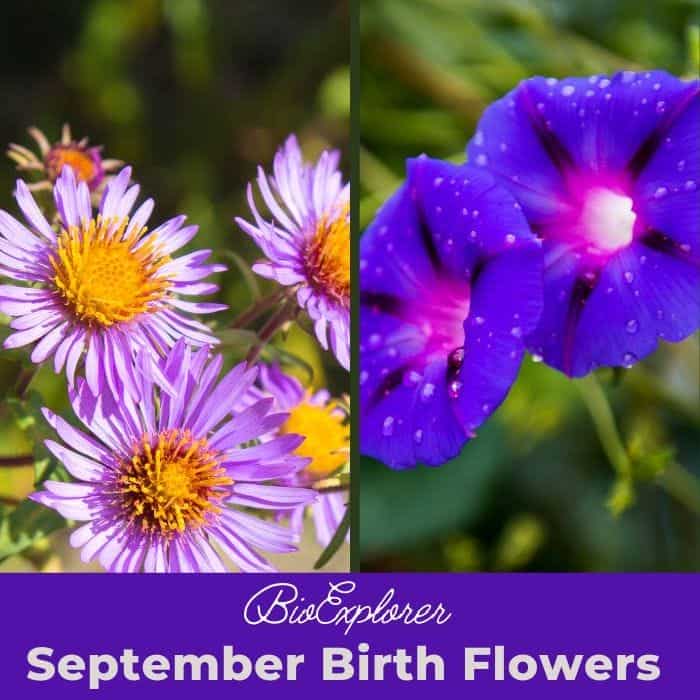
Have a birthday in September and wondering what flower represents your birth month? You’re in luck as September has not one but two beautiful Birth Flowers – the Aster and Morning Glory.
In this blog post, we will delve into the origins, symbolism, and special meanings of these blooms and their cultural significance across different societies. Ready to uncover what your September bloom says about you? Read on!
Key Points
- September has two birth flowers, the Aster and Morning Glory.
- asters mean love, wisdom, beauty, and faith. They come in many colors, like purple and pink.
- Each color of an aster has a special meaning. For example, red stands for deep love.
- Morning glories also stand for affection but only live for one day.
- This flower comes from China and Japan but grows almost everywhere now.
- September babies can use these facts to understand more about their birth flowers!
Table of Contents
- Overview of the two flowers for September: Aster and Morning Glory
- Aster: The Primary September Birth Flower
- Aster Facts and Varieties
- Interesting facts about Asters
- Aster Common types and varieties
- Giving Asters
- Morning Glory: The Second September Flower
- Morning Glory Facts and Varieties
- Interesting Facts about Morning Glories
- Giving Morning Glories
- Frequently Asked Questions
- Why are there two birth flowers in September?
- What’s the best way to care for asters and morning glories?
- What is the meaning behind September’s birth month flower?
- What does the birth month flower of September signify?
- Can September birth flowers bloom during autumn?
- What is the symbolism of Morning Glory flowers?
- How were Asters used medicinally?
- How does the Aster flower get its name?
- What makes Aster and Morning Glory different from the birth flowers of other months?
- Can Asters and Morning Glories be used in bouquets?
- How are the birth flowers in September related to their respective symbolism?
- Conclusion
Overview of the two flowers for September: Aster and Morning Glory
Aster and Morning Glory are the two birth flowers for September. Asters symbolize love, wisdom, and beauty. They also stand for faith and purity. Morning glories show love, too! They also speak of life’s brief time.
These flowers open up in the morning only to close at night. People born in September have these two beautiful flowers to represent them.
Aster: The Primary September Birth Flower
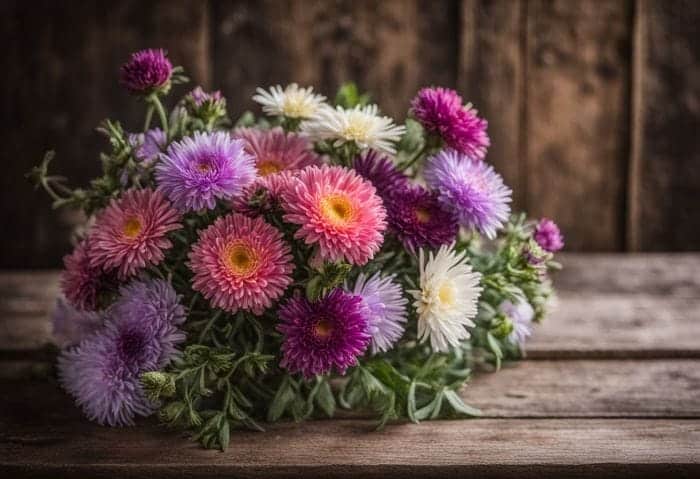
Asters are flower stars! They stand for love, wisdom, and beauty. These flowers also mean faith and being a good friend. Asters come in different colors, but you will see them most in purple and periwinkle shades.
This gives the asters a feeling of elegance. The month of September claims asters as its birth flower. What’s more exciting about these flowers? The name Aster says it all! It means “star”, since the blooms look like little stars shining in your garden or bouquet.
Origins and Cultural Meaning Behind Asters
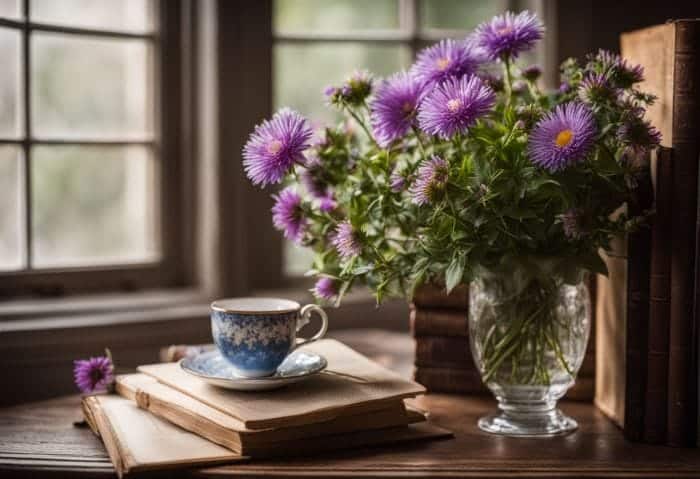
Asters come from Greece. The word “aster” means “star” in Greek. These star-shaped flowers have a deep meaning in Greek myth[1]. There is a story about the god Astraea, who was upset when she saw no stars on Earth during the day.
She began to cry, and where her tears fell, asters grew.
People in many cultures love asters for other reasons, too. Asters stand for elegance, love, purity, and innocence. They also show deep love and passion. In some places, people smoke from burning Aster leaves to keep away bad spirits.
This makes these little flowers not just pretty but powerful, too!
![]()
Aster Represents wisdom, faith, and valor
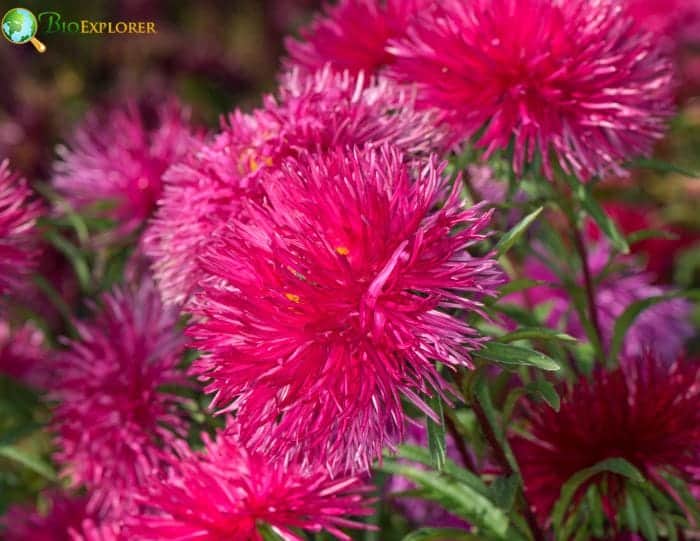
The Aster is a special flower. It means wisdom, faith, and courage. Those born in September have this as their birth flower. They are brave, wise, and faithful. In history, people have linked the Aster to being patient and pure.
These small star-like flowers show love, too. They are much more than pretty blooms!
![]()
Different colors of Aster have additional symbolism
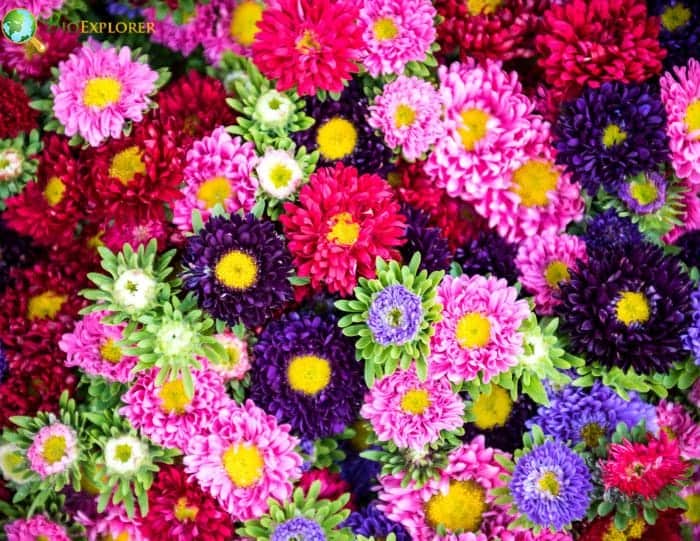
Aster flowers, with their wide range of colors, carry unique symbolism. Each hue represents a different sentiment according to the Victorian language of flowers[2] and ancient cultural associations.
| Pink | Associated with deep, undying love, pink asters are given to express profound affection. |
| Red | Similar to pink asters, red asters also symbolize deep love and are often presented as a sign of passionate desire. |
| Purple | Purple asters carry a sense of regal majesty and enchantment, according to the Victorian language of flowers. |
| Blue | Blue asters symbolize patience and faith, embodying a serene and positive energy. |
| White | White asters encapsulate innocence purity, and also denote genuine love and affection. |
Each color of the Aster flower presents an opportunity to communicate different sentiments and emotions, making them an expressive choice for various occasions.
![]()
Aster Facts and Varieties
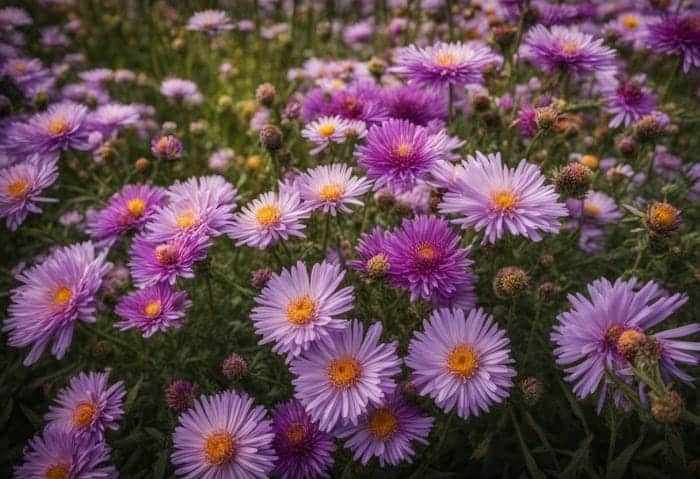
Asters shine like stars in the night sky. Their name comes from a Latin word that means “star”. There are many colors of this flower. You can find asters in purple, pink, blue, and white.
They look like small daisies.
These flowers grow well in the fall season. Asters and chrysanthemums are close family members! From old times, people have used asters as a symbol of love that lasts forever. This makes them very special flowers indeed.
Aster Scientific name, genus, species
The Aster flower is a star in the garden. Its scientific name is Asteraceae. The genus name “Aster” speaks to its looks. It comes from the Latin word “astrum”. This means “star”. There are many species or types of Aster flowers, each with its beauty.
![]()
Aster Growing season, planting, care
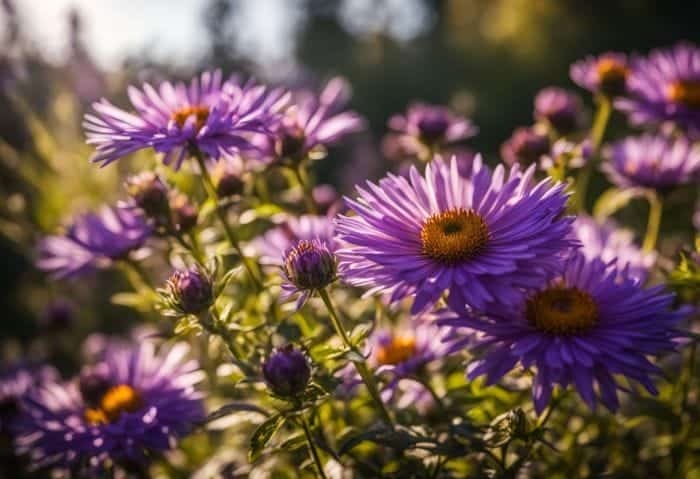
Asters bring joy to a garden in the fall. Here are the steps to grow and care for them:
- Asters bloom from late summer into the fall.
- They like full sun, but they can also grow in partial shade.
- Plant asters in moist, well-draining soil.
- Space the plants about 1 to 3 feet apart.
- Water your asters regularly; they don’t like dry soil.
- Keep an eye out for pests like slugs and snails.
- Cut back old Aster stems in late autumn to keep them tidy.
- Asters symbolize affection, renewal, and rejuvenation, making them a special flower to have in any garden.
- These flowers are linked with love and patience, too.
- Having asters in your garden also brings elegance and stars to your night sky.
![]()
Interesting facts about Asters
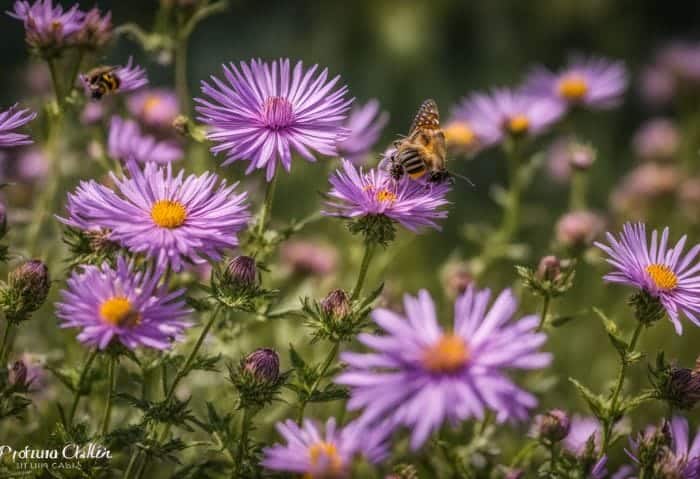
Asters are very special. They are more than just pretty flowers. These star-shaped flowers have a secret. Asters can talk to bees and butterflies in their way! Yes, these little blooms send signals only bees and butterflies can see.
So, they help bring these helpful bugs to your garden! People also used asters a long time ago as medicine. Not just that, some people even believe burning aster leaves will keep bad spirits away from them!
And did you know there was something called the “Aster Revolution“?
It was not about the flower[3], but it sure made this flower famous all over again! Cool, isn’t it?.
Aster Common types and varieties
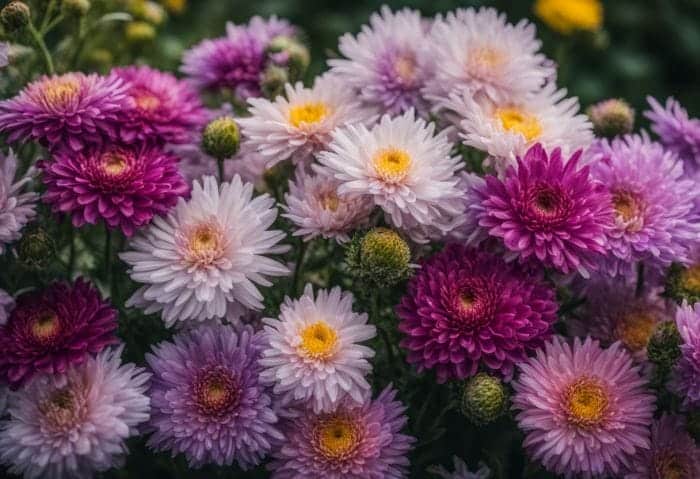
There are many types of aster flowers. Here is a list to help you know them:
- New England Aster: This type has big, purple flowers. It loves full sun and attracts bees and butterflies.
- Italian Aster: This kind blooms in late summer with white or pink flowers.
- Wood’s Purple: Deep purple flowers bloom in the fall.
- Frikart’s Aster: These asters have blue, daisy-like flowers.
- Alpine Aster: This type grows well in rocky soils. Its flowers can be white or pink.
- Starwort: This Aster can grow very tall with blue or violet petals.
- White Woodland Aster: As its name shows, it has white flowers and grows well in wooded areas.
- Seaside Aster: These asters love the seaside and show off their light purple petals from late summer to early fall.
- Smooth Blue Aster: With beautiful Blue Blooms, this variety thrives under the sun.
- New York Aster: Another popular variant with purple-blue blossoms that last till late autumn.
Giving Asters
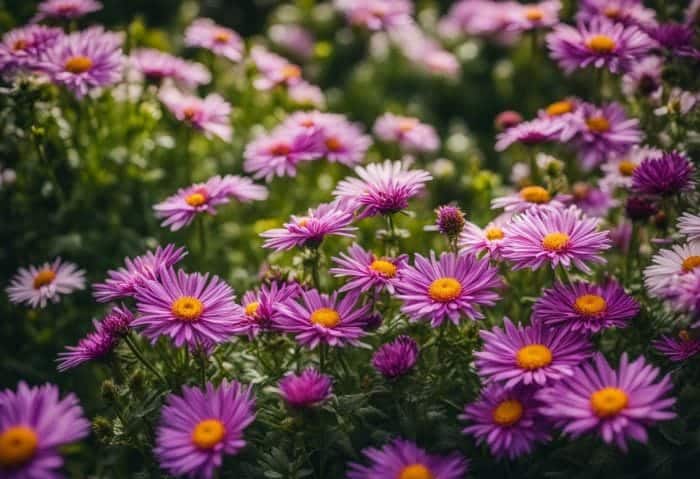
Asters stand for love and wisdom. They make a great gift for September birthdays. You can give asters on other days too. For example, red asters mean deep love. A bunch of these would be good on Valentine’s Day.
There are also white asters, which people see as a sign of patience and loyalty.
Choose the color based on what you want to say with your gift. The aster bouquets should match the event or feelings you wish to express. Giving asters is a sweet way to tell someone they are special to you.
Why do asters make great September birth gifts?
Asters make great gifts for September births. These pretty flowers show love and wisdom. They also stand for faith and friendship. The color purple is a key feature in asters. This makes them seem magical and neat to look at.
In old times, people thought these flowers stood for true love and trust. So, giving asters as a gift tells the person how much you care about them on their special day.
![]()
Best occasions to give asters
Giving asters is a good idea on many occasions.
- They are great for September birthdays because they are the birthflower for this month.
- Asters also make a beautiful gift for anniversaries. Their long ties to love and beauty make them perfect to share with your loved one.
- You can give asters as a thank you gift too. Their links to friendship and purity especially show gratitude.
- Lastly, if someone needs a pick-me-up, bring them asters! These flowers stand for patience and might lift their mood.
![]()
How do you choose the right aster colors?
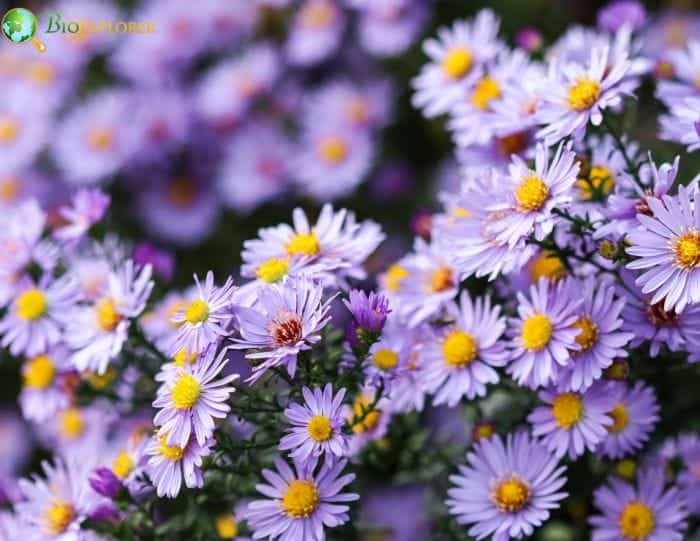
Picking the right aster color can be simple. It depends on the meaning you want to send or the likes of your gift receiver. Red asters stand for love. White ones mean innocence and purity, while pink ones show strong feelings.
Notice that asters come in sunset hues like red, blue, white, or pink. So, these bright colors can light up any room. Always match the color of your asters with what they symbolize and who will get them.
With this tip, choosing the right aster color becomes a piece of cake!
![]()
Morning Glory: The Second September Flower
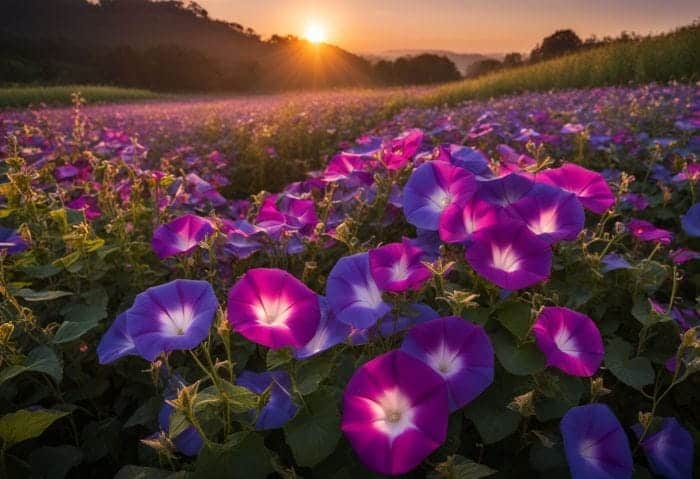
Morning Glory shares the honor of being a September birth flower. This bloom is part of a big family with over 1,000 types[4]. Love that was not returned is one thing it stands for. Sad but true – morning glory dies the same day it opens.
This flower shows love, warmth, and wishful thoughts. But its life is short. In just one day, it blooms and dies off. Even so, people born in September still love this quick-lived beauty!
Morning Glory Origins and Significance of Morning Glories
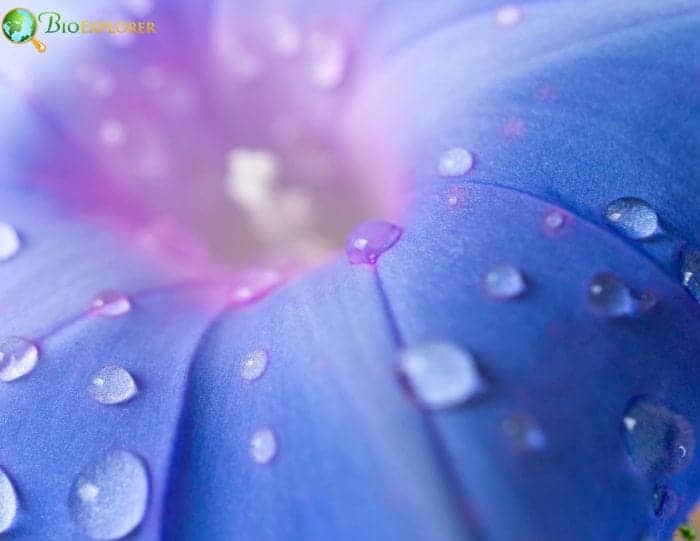
Morning glories started in China and Japan. They were used for their strong ropes and as medicine. From there, they traveled all over the world. The seeds even went into space! Now, morning glories grow almost everywhere.
These flowers mean a lot to people. They show love that is not returned but also love that lasts forever. Each color of the flower has its meaning, too. For example, blue means trust, while pink shows warmth and happiness.
Morning glories bloom only for a day and then die off, showing our short life.
In old English times, people gave meaning to these flowers, too. They said it was simultaneously about love in vain or being pretty but fragile.
Finally, morning glories stand for pure unconditional love, making them special!
![]()
Morning Glory Represents Affection and Mortality
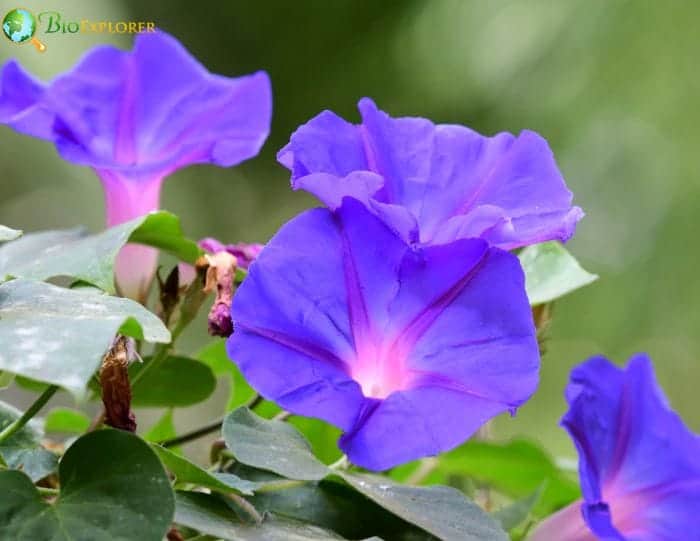
Morning Glory is a special flower for September. It shows love and the end of life. This flower stands for strong feelings and death. People believe it shows pure love that lasts forever.
Morning Glory can also show love that gets lost or doesn’t work out. So, anyone with this birth flower will have deep relationships and know all kinds of love.
![]()
The meaning behind Morning Glory colors
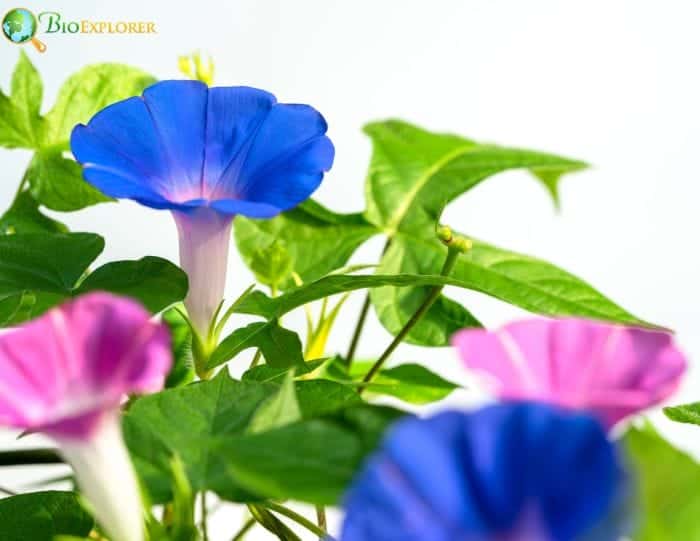
Morning glory colors talk a lot. A purple morning glory shows love and care. It says, “I have deep feelings for you“. Other shades tell different love stories. Each shade has its way of showing love.
These flowers are also about being strong and not giving up. They live even in hard times. Morning glories say, “You can do it! You are tough!” Just like them, we can grow in rough places, too.
These flowers send a message of hope.
![]()
Morning Glory Facts and Varieties
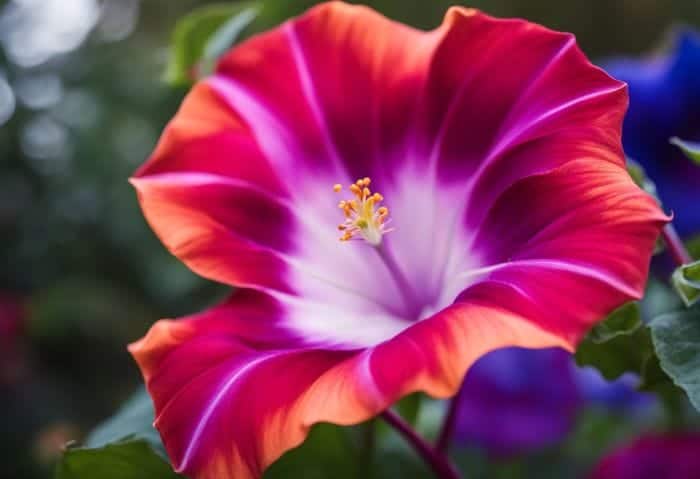
Morning Glory is a unique birth flower for September. It shows love and warmth to people born in this month. The flowers of morning glory shine in many colors. They can be white, red, blue or pink, and purple too! Every color carries a special meaning, like pure love or trust.
You can grow morning glories both ways – climbing walls or sitting in pots. These plants are not picky! Their lovely blooms will add grace to any place you grow them. So, these were some fun facts about the versatile morning glory.
Morning Glory Scientific name, genus, species
The morning glory is a pretty flower. Its name in science sounds hard, but it’s not. It is called Ipomoea purpurea. This also tells us what group of plants it comes from. That group is named Ipomoea.
![]()
Morning Glory Growing season, planting, care
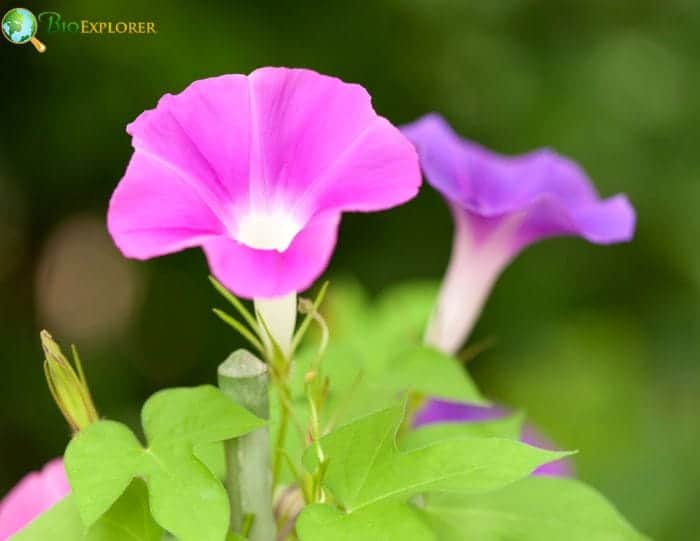
Morning Glories are easy to take care of. Here are some tips:
- Choose a spot with full sun for planting Morning Glories. They love the sun.
- Plant them in the spring after the threat of frost has passed.
- Make sure the soil is well-drained where you plant them.
- Placing seeds about 6 inches apart in the ground would be best.
- Water them regularly, but don’t let water sit around the roots.
- These plants grow fast once they start, so give them a fence or trellis to climb on.
- Watch out for pests like bugs and birds that might harm your flowers.
- Your Morning Glories will bloom in early summer and keep going until fall.
- They open their pretty flowers early in the day and close up when it gets warm (see Important Facts).
- Keep your Morning Glories away from harsh winds which may harm them.
![]()
Interesting Facts about Morning Glories
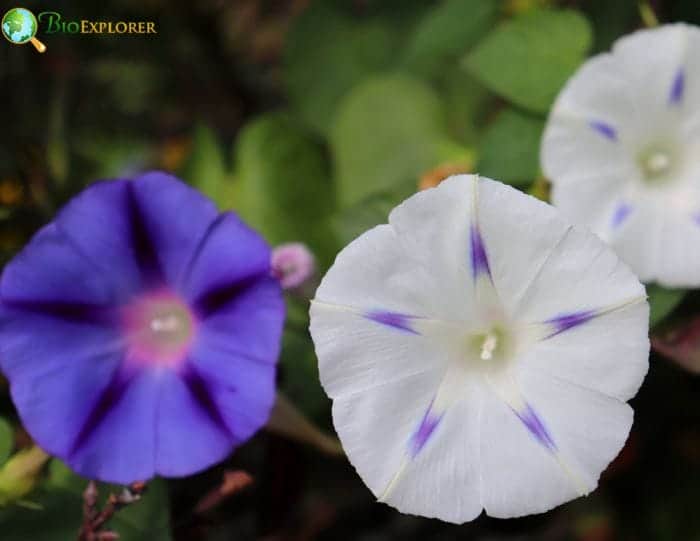
Morning glories are not just pretty. They have a lot of cool things about them. One fun fact is that they open their flowers in the morning and close them at night. That’s why we call them “morning glories”.
These flowers show many colors. You can see white, red, pink, blue and even purple.
Did you know that morning glories also speak a special language? This is how it goes in old times: if someone gives you a morning glory flower, it means they feel love for you, but it’s not working out.
So, these small but bright blooms do more than add beauty to your garden; they tell stories, too!
Common Types and Varieties of Morning Glory
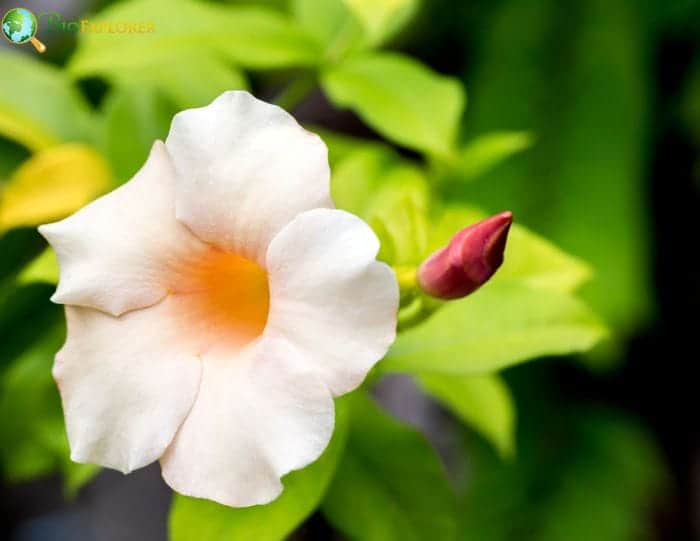
There are over 1000 species of Morning Glory flowers identified so far. Here are some common ones:
- Heavenly Blue Morning Glory (Ipomoea tricolor): These are known for their vibrant blue flowers with a white center, commonly grown in gardens across North America.
- Common Morning Glory (Ipomoea purpurea): This variety displays flowers in shades of purple, pink, and white and is a favorite in many gardens worldwide.
- Japanese Morning Glory (Ipomoea nil): They showcase a range of colors and intricate patterns, often cultivated in Japan and other parts of Asia.
- Moonflower (Ipomoea alba): Blooming at night, they have large, fragrant, white flowers, making them a unique addition to gardens.
- Cypress Vine (Ipomoea quamoclit): Recognized by its feathery leaves and small, star-shaped red or white flowers, it’s a popular choice in Southern U. S. gardens.
- Sweet Potato Vine (Ipomoea batatas): While grown mainly for its edible tubers, it also produces ornamental flowers in shades of lavender to light pink.
- Ivy-leaved Morning Glory (Ipomoea hederacea): With Ivy-like leaves, this variety blooms in blue, purple, or pink, commonly found in North and South America.
- Blue Dawn Flower (Ipomoea indica): This vigorous climber is adorned with deep blue flowers and is often seen in tropical and subtropical regions.
- Railroad Creeper (Ipomoea cairica): A robust climber, it has pinkish-purple flowers and is commonly found in tropical areas and some temperate regions.
- Cardinal Climber (Ipomoea sloteri or Ipomoea x multifida): Known for its bright red, trumpet-shaped flowers and finely cut leaves, it’s a favorite in many North American gardens.
![]()
Giving Morning Glories
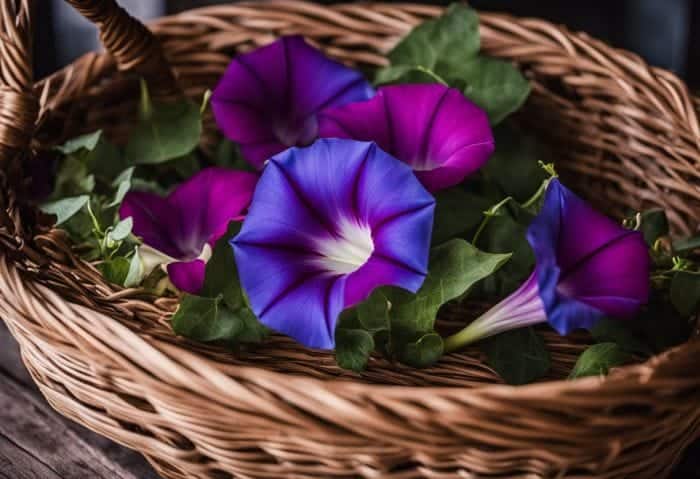
Morning glories make perfect gifts for September birthdays. These pretty flowers stand for love and warmth. When you give morning glory to someone, it tells them how much you care about them.
They are great gifts for friends, family members, or anyone special in your life.
Picking the right color of morning glory is also important. Different colors show different kinds of love and affection. For instance, purple morning glories speak of deep love, while pink ones tell of sweet feelings of fondness.
So next time when looking for a thoughtful gift, think about giving some beautiful morning glories!
Why do Morning Glories make thoughtful September gifts?
Morning glories are a smart gift for September birthdays. They stand for love and warmth. A gift of morning glories says you care a lot. The colors also mean different things. Pink ones show energy and thanks.
So, someone with a birthday in September would love to get them!
![]()
Best occasions to give morning glories
Giving morning glories is a thoughtful act. Here are the best times to gift these beautiful flowers:
- Share them on a wedding day. Morning glories symbolize pure and deep love.
- Give them an anniversary gift. They remind us of love that stands the test of time.
- Hand them over at a goodbye party. Their fleeting life shows how all things pass.
- Present them in a bouquet for a new mom in September. They will honor her baby’s birth month.
- Use them to cheer up someone ill. Their bright colors bring joy and hope.
- Gift them during family reunions. They promote strong family ties and warmth.
- Surprise a person born in September with morning glories, as their birth flower it holds special meaning for them.
![]()
How to select the right morning glory colors?
Picking the right color of morning glory is key. Each color holds a special meaning. Purple flowers show your spiritual side. Blue ones help to bring peace and calm. Give pink morning glories to show love and care.
White blossoms speak of pureness and being true in heart, while red blooms express deep passion and feelings. The right choice will send a strong message without words.
![]()
Frequently Asked Questions
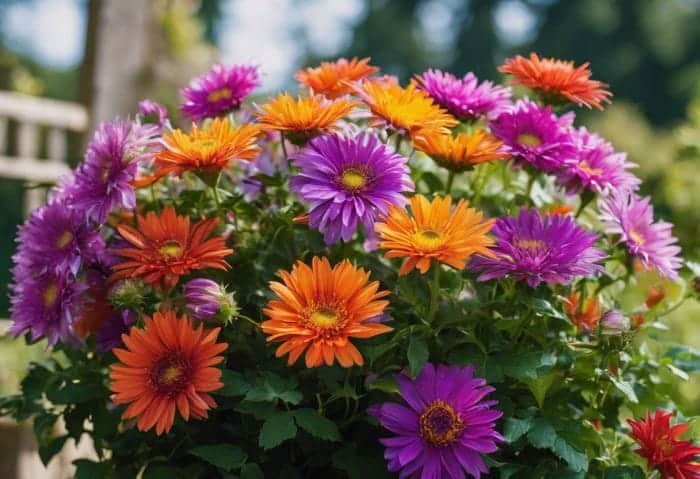
People often ask why there are two flowers for September. The birth flowers are the aster and morning glory. Both of these have special meanings tied to this month.
A common question is how to care for these plants. Asters need full sun or light shade to grow well. They also like rich soil that drains well. On the other hand, Morning glories love sunlight too, but they can make do with dry soils.
Why are there two birth flowers in September?
September has two birth flowers, the Aster and the Morning Glory. This double honor comes from old traditions. Long ago, people from different cultures picked their own flowers for each month.
Over time, these choices got mixed up together. So now, some months have more than one flower. In September, Asters got picked because they bloom well in late summer and early fall.
They are like a happy hello to the new season! Morning Glories also made it into September’s spot because their stunning blue hue brightens the start of cooler days.
What’s the best way to care for asters and morning glories?
Taking care of asters and morning glories is easy. These plants need water often and soil that lets the water out well. Asters like being in full sun all day. They can grow very tall, so you may need to stake them up so they don’t fall over.
Morning glories are lianas or climbing vines that love to climb. Please give them a trellis, fence, or any support they can latch onto as they grow upwards. Keep your asters and morning glories looking good by cutting back old stems regularly throughout the year.
This helps new stems to come through, keeping your flowers healthy and strong.
What is the meaning behind September’s birth month flower?
The Aster, one of September’s birth month flowers, derives its name from the Greek word for “star, ” signifying love and patience. The morning glory, another September birth month flower, also has significant symbolism, often associated with affection, mortality, and life’s eternal ebb and flow.
What does the birth month flower of September signify?
The birth month flower of September signifies enduring love, wisdom, and courage. The Aster is also known to ward off evil spirits. The morning glory symbolizes unrequited love and the fleeting nature of life, as its flowers open in the morning and die by day’s end.
Can September birth flowers bloom during autumn?
Yes, the aster and morning glory, the September birth flowers, bloom during the fall season. They are often seen in various colors, decorating gardens and making beautiful floral arrangements.
What is the symbolism of Morning Glory flowers?
Morning Glory flowers are symbols of affection, mortality, and the circle of life. Their unique ability to open in the morning and die by the day’s end denotes the fleeting beauty of life and the need to appreciate every moment.
How were Asters used medicinally?
Historically, asters have been used for medicinal purposes due to their healing attributes. They were used to ward off evil spirits and even treat snake bites. The blooms also served as a reminder to take care of one’s health and overall well-being.
How does the Aster flower get its name?
The Aster flower gets its name from the Greek word meaning “star”. This is due to its star-like appearance, which stands out in floral arrangements and inspires a sense of love and patience.
What makes Aster and Morning Glory different from the birth flowers of other months?
Aster and Morning Glory, the two birth flowers of September, are unique in their symbolism and meaning. Unlike the birth flower of August or November, they both have two significant meanings. Asters symbolize love patience, and are known to ward off evil spirits. Morning glory, conversely, is said to signify affection and the fleeting nature of life.
Can Asters and Morning Glories be used in bouquets?
Absolutely! The Aster and Morning Glory’s vibrant colors and distinctive shapes make them an excellent choice for various floral arrangements, including bouquets. Not only do they bring aesthetic beauty, but their respective symbolism also adds a thoughtful touch to a bouquet.
The birth flowers in September, Aster, and Morning Glory, carry distinct symbolic meanings. The Aster, deriving its name from the Greek word for ‘star’, symbolizes love and patience. In contrast, the Morning Glory signifies affection and the fleeting nature of life, given its characteristic of blooming in the morning and dying by day’s end. This symbolism is derived from their unique growth patterns and role in historical beliefs and customs.
![]()
Conclusion
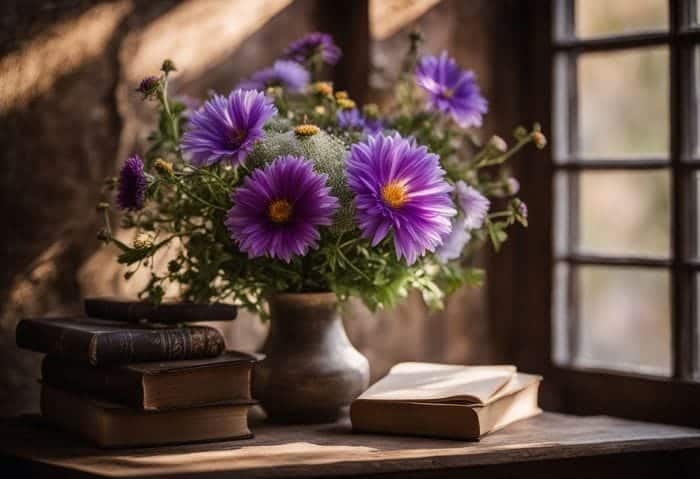
Appreciating September’s birth flowers adds a special touch to the month. The lovely Aster and Morning Glory are unique symbols of love, wisdom, strength, and more. Learn how these blooms talk without words through their colors and shapes.
Make them your heart’s voice on special occasions this fall season!
















